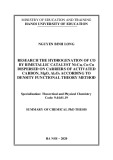
Density Function Method
-
Research purpose: Using computational chemistry methods to study the mechanism of hydrogenation CO on the transition metal catalyst systems of Ni, Cu, Co, bimetallic catalysts NiCu, CoCu and catalytic systems bearing cluster on oxide carriers: MgO, Al2O3 and activated carbon (AC); compare and clarify the role of catalyst centers in single or bimetallic catalyst systems; clarifies the role of carriers (MgO, Al2O3 and AC) in the hydrogenation of CO.
 27p
27p  thebadguys
thebadguys
 08-06-2021
08-06-2021
 29
29
 4
4
 Download
Download
-
Purpose: Using the density functional method (DFT) to find out the mechanism of CO2 hydrogenation reaction, the main product, by-products, the optimal reaction path, compare and evaluate the catalytic ability of the Ni5 cluster, Ni5/MgO, and Ni5/AC.
 25p
25p  thebadguys
thebadguys
 08-06-2021
08-06-2021
 13
13
 3
3
 Download
Download
CHỦ ĐỀ BẠN MUỐN TÌM















